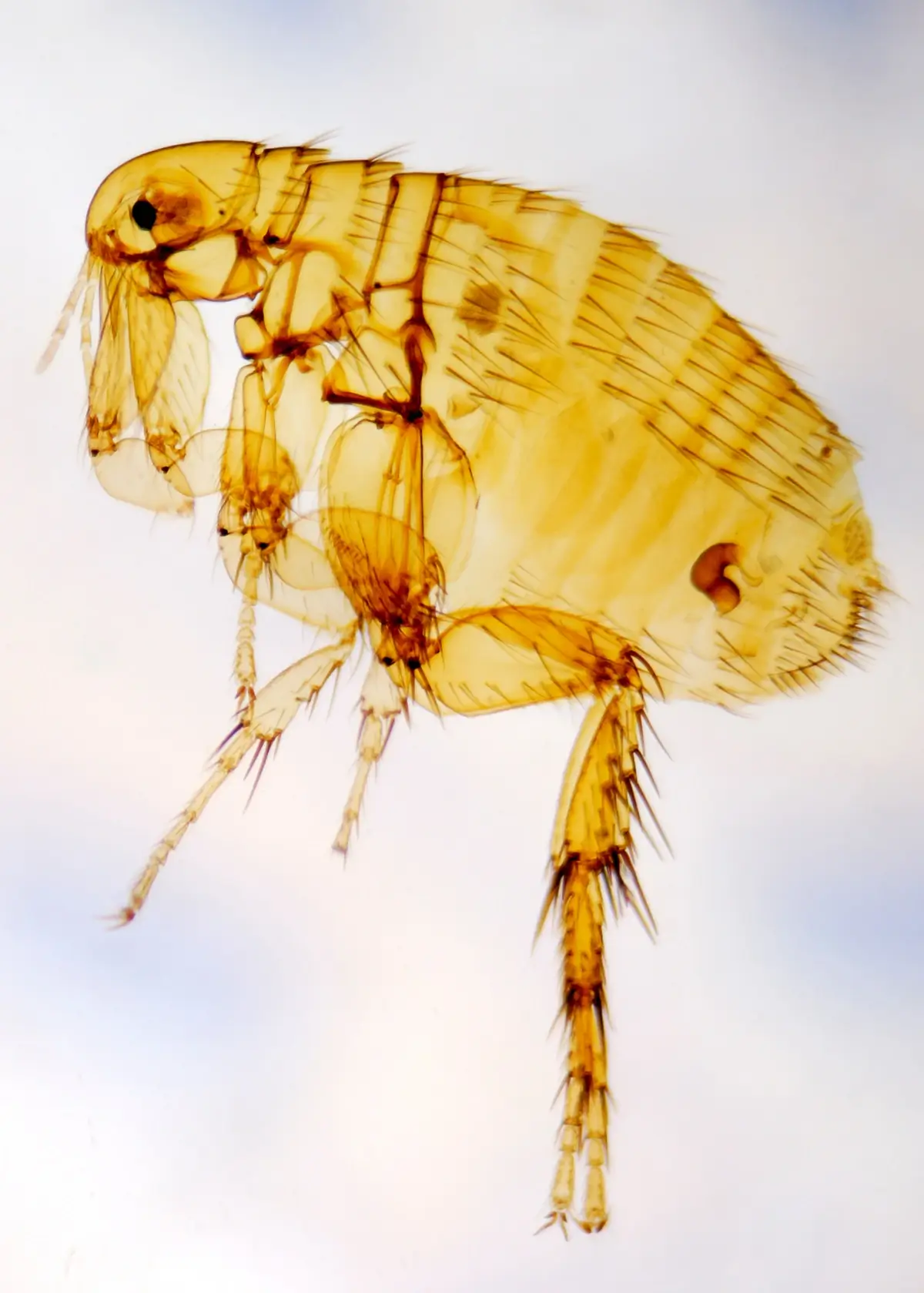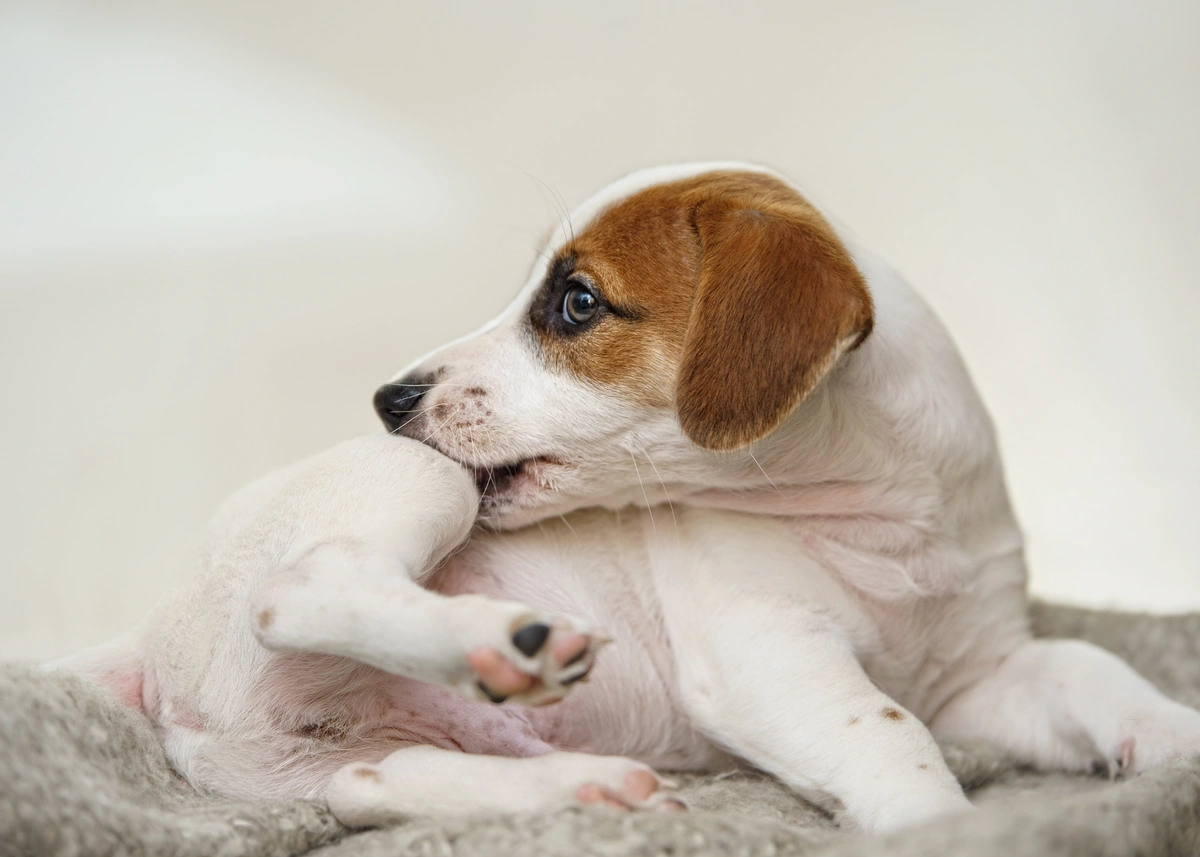We are sorry in advance if this post makes you itchy, but we have to talk about a dreaded nuisance no puppy owner wants to experience – fleas!
If only the moment you discover fleas on your puppy could be like in the cartoons where you see tiny insects walking on a tightrope and performing other tricks in their animated flea circuses!
Instead, you see small, sesame-seed-like insects jumping around and black, gritty flakes around irritated skin where they’ve feasted on your puppy’s blood. And of course, you immediately start to itch and feel like your skin is crawling (which might actually be true with fleas jumping all over you).
Fleas are not a modern pestilence, as they have been around since dinosaurs roamed the earth as evidenced by flea-like species found preserved in amber from the Cretaceous and Jurassic eras. You may remember learning about the flea, not in science class, but in world history class. The flea was responsible for bacterial Bubonic plague Black Death outbreaks in the 1300s and 1600s. Rats carrying infected fleas would travel all over the world on ships, and fleas would find an international buffet at their new ports.
Today, a flea infestation is among the top most worrying and overwhelming situations puppy owners face. They can wreak havoc on the health of your pet and the comfort of your family members in your home. Thankfully, several methods exist for preventing fleas on your puppy in the first place. Learning how to recognize, prevent, and treat flea infestations is the key to keeping your puppy protected from fleas.
What Exactly Is a Flea, Anyway?
A flea is a small insect about ⅛ inch long fully grown that survives on blood from a warm-blooded body. They are considered a parasite because they can transmit diseases and parasites to their victims. They have no wings; instead, fleas can jump from host to host. Fleas have powerful mouthparts and 3 sets of legs. Fleas can carry tapeworms, bacteria, diseases, painful skin conditions, and cause anemia in severe cases.
Centers for Disease Control and Prevention's Division of Vector-Borne Diseases (DVBD)
The life cycle of a flea
A flea has a 4-part life cycle. Understanding each life cycle will help you both prevent and treat a flea infestation, as you need to know how to treat each stage of its life cycle to fully rid your puppy and your environment of fleas. Remember, when you see one flea, it’s like seeing the tip of one iceberg in a field of floating ice. You’re definitely going to have the other stages thriving in your home and on your puppy.
-
Egg: An adult flea will mate and lays eggs on your puppy after a delicious blood meal. These eggs are half a millimeter long and look like opaque ovals and take 1-10 days to hatch. They fall onto your puppy’s surroundings such as their bed, on and under the couch, or outside in a favorite spot.
-
Larvae: Here’s where it starts to get gross if you aren’t grossed out already. The eggs hatch larvae and start eating dead skin flakes and blood from flea feces. Larvae are white hair-covered worm-looking specimens 2-5mm long. They feast and grow for 5-20 days.
-
Pupa: The pupa stage begins when larvae spin a cocoon that protects them from environmental hazards – the very same ones you attempt to use when treating fleas. The flea undergoes metamorphosis into a grown flea, just like a caterpillar turns into a butterfly. Another concerning fact is that pupae can hang out for nearly a year (usually 30-75 days) waiting for a host if one is absent. Pupae can remain hidden in the fibers of your carpet, crevices of your couch, your car (yes, your car) or anywhere your pet likes to be. The pupa stage is one of the main causes for why it’s so hard to get rid of fleas and why treating visible adult fleas is just the beginning.
-
Adult: Changes in temperature, vibrations, and other factors tell an adult flea when to emerge when the timing is right. They will find a host within 24 hours. After a blood meal, they can find other fleas to mate with, and the cycle continues.
Facts about Fleas to Make Your Skin Crawl
- According to veterinarian dermatologist Dr. Chris Reeder, “One adult flea can lay up to 50 eggs per day. Even if 10% hatch, then that would be five fleas from one female.”
- There’s not just one type of flea. We hate to break it to you, but there are 2,500 flea species on Earth and 300 in the US!
- The main type of flea found on puppies is weirdly enough, not the dog flea. It’s actually the cat flea (Ctenocephalides felis) that transmits bacteria, parasites, and other disgusting things needing a host.
- Despite their tiny size, fleas can jump up to 13 inches, 200 times their own body length.
- Female fleas can drink up to 15 times their body weight in blood in their lifetime.
- Diana C. Zentko and Dina L. Richman at the University of Florida report that an estimated $2.8 billion is spent annually on flea-related veterinarian bills. Pet owners spend an estimated $1.6 billion annually for flea treatment through groomers, $4 billion for over-the-counter treatments, and $348 million for professional flea control.
How Can I Tell My Puppy Has Fleas?
The first sign could be obvious – you see them jumping and crawling around. You may notice your puppy scratching or biting certain spots more frequently. Another tell-tell sign can be found on your puppy’s skin. You may have noticed salt-and-pepper-like black specs often surrounding irritated spots on the skin. We hate to tell you, but the specks are actually flea excrement full of blood!
Prevent Fleas with These Methods
The best way to prevent fleas is to have your puppy on year-round flea prevention treatment for dogs. Your veterinarian will be the best person to turn to for the right method for your puppy. Available options include both prescription and over-the-counter preventative all-in-one oral pills (for flea, tick & heartworm prevention), topical flea treatment applied on the back of the neck, flea collars, special flea shampoos and wipes, and yard treatment.
Outside of the vet’s office, there are several effective ways to prevent fleas from infesting your dog:
-
Regular grooming: Regularly brush your dog's coat to examine the skin for any irritation, flea bites, or “flea dirt.” This helps in early detection and prevents infestation.
-
Clean bedding and surroundings: Wash your dog's bedding and soft toys regularly in hot water to kill any fleas or eggs. Vacuum your home frequently, paying particular attention to areas where your dog spends time. Be sure to empty the bag or canister and keep that clean as well.
-
Environmental control: Treat your home and yard with flea control products to eliminate fleas from the environment. This reduces the chances of re-infestation.
-
Avoid contact with infested animals: Prevent your dog from coming into contact with infested animals, as fleas can easily transfer from one host to another.
-
Maintain a clean outdoor environment: Keep your yard free from debris and trim grass regularly to discourage flea breeding and infestation.
By following these flea prevention measures consistently, you can significantly reduce the risk of flea infestation in your dog, ensuring their comfort, health, and happiness. Remember, early prevention is key to keeping your dog free from these pesky parasites.
What to Do if Your Puppy Has Fleas
Always call your vet if you suspect your puppy has fleas. They will be able to tell you what to do, and your vet might even want to see your puppy in the office right away. You’ll need to take action right away, as you’ve learned there’s a lot more going on if you spot one adult flea.
If you’re wondering how to get rid of fleas, several methods online are good for a temporary fix, but there are other stages of a flea’s life cycle to kill other than the adult stage. For this reason, we definitely recommend getting the advice of a licensed professional extermination company that can tell you the most effective treatment methods for the presence of fleas.
From DIY to powerful treatment chemicals, here are some methods professional exterminators and your vet may recommend so you can have an idea before you call.
Clean areas
Just like above when talking about flea prevention, start washing everything in sight in hot water, including all washable items where your pet lives, clothes, bedding, toys, etc. Vacuum the rugs, floors, curtains, furniture, under all furniture, and your car. Keep in mind that washing and vacuuming is just a start and will not remove all the infestation.
Dish soap
Dish soap, particularly blue Dawn dish soap, can be an easy, inexpensive, and temporary place to start your efforts to get rid of fleas while you look for other methods to treat the entire lifecycle. If you mix a bit of dish soap in water and place it near the affected areas next to a light, you may attract and drown them.
Likewise, washing your pet with dish soap will help kill adult fleas on impact. The surfactants in the soap affect the flea’s exoskeleton, rendering them unable to float on the surface of the water, causing the fleas to drown.
Food-grade diatomaceous earth
Food-grade diatomaceous earth is a natural, powdery substance that is highly effective in killing fleas. When fleas come into contact with diatomaceous earth, the microscopic particles stick to their bodies. The sharp edges of these particles puncture the protective outer layer of the fleas, causing them to lose moisture rapidly.
As a result, the fleas become dehydrated, leading to their eventual death. Diatomaceous earth is non-toxic to humans and animals, making it a safe and environmentally friendly option for flea control.
Flea products
Both over-the-counter and prescription flea products paired with a special flea comb can work together to remove different stages of flea growth on your puppy. Whether you or your vet administers the product, always make sure to follow the directions exactly.
Flea bombs and over-the-counter insecticides
Flea bombs can be a useful treatment, but sometimes not even a flea bomb will reach every egg, larva, pupa, or flea. It’s vitally important to read the instructions and keep people and pets away from the bombed area according to the directions to use the products safely.
Keep trying & have patience
If you can’t reach an extermination company, research more! Keep calling until you get a consultation. Your flea problem will continue to get worse. Even if you don’t see any adults left, remember – there could be more despite your best efforts, and no one wants surprise fleas after you’ve done all the DIY flea treatments you’ve heard about!
Remember that fighting a flea infestation requires persistence and thoroughness. It may take some time to completely eradicate the fleas, but with a comprehensive approach and consistent efforts, you can protect your puppy from these irritating parasites.
Flea-Free Puppies for Sale at Pawrade
If you’re looking for puppies for sale, Pawrade guarantees healthy puppies that arrive in your loving arms flea-free. Our trusted breeder partners work tirelessly to maintain safe, sanitary environments for their puppies to grow into little wiggly, furry friends ready to come home to you.






